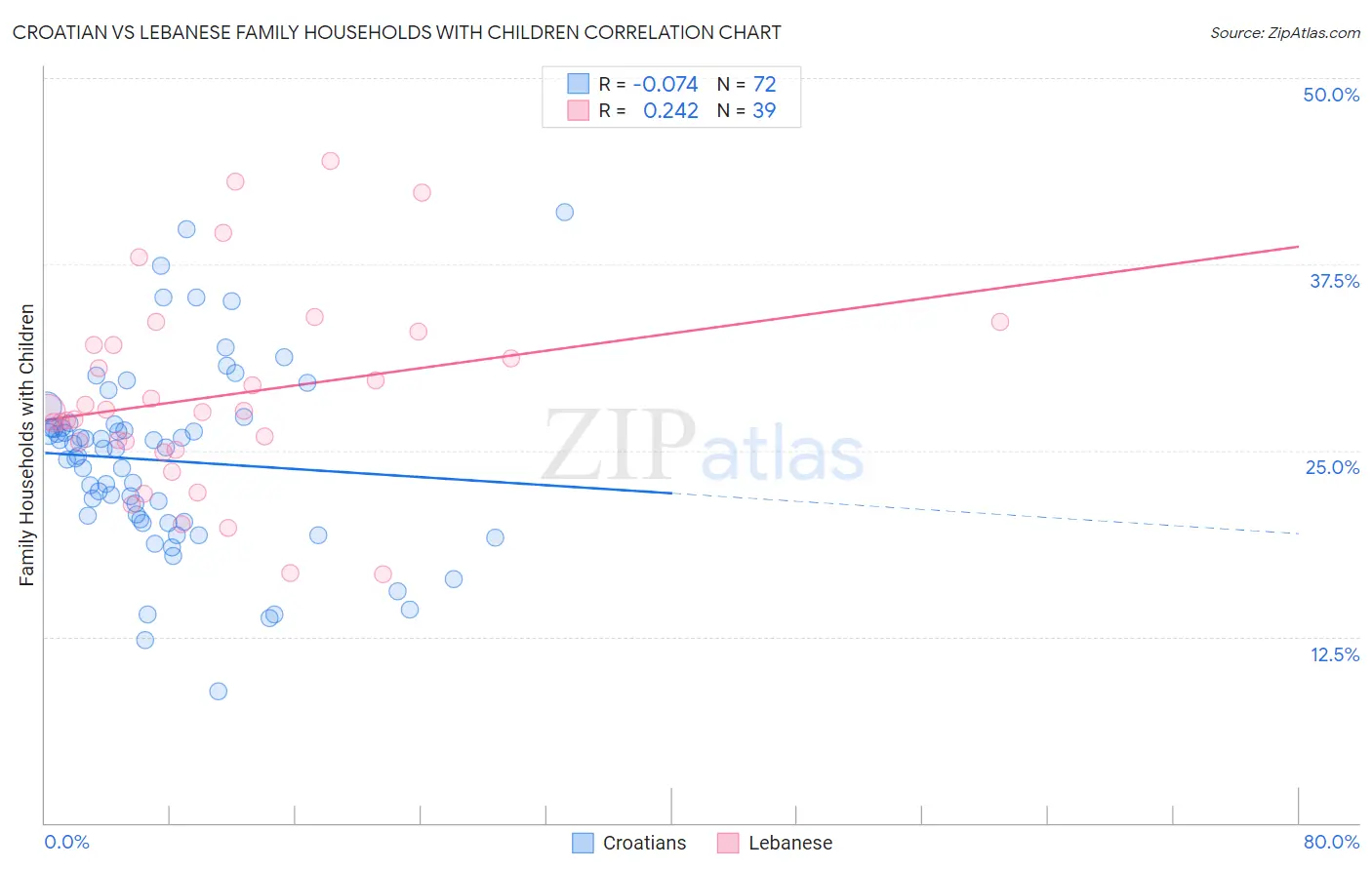Croatian vs Lebanese Family Households with Children
COMPARE
Croatian
Lebanese
Family Households with Children
Family Households with Children Comparison
Croatians
Lebanese
26.4%
FAMILY HOUSEHOLDS WITH CHILDREN
0.1/ 100
METRIC RATING
296th/ 347
METRIC RANK
27.7%
FAMILY HOUSEHOLDS WITH CHILDREN
87.4/ 100
METRIC RATING
131st/ 347
METRIC RANK
Croatian vs Lebanese Family Households with Children Correlation Chart
The statistical analysis conducted on geographies consisting of 375,401,483 people shows a slight negative correlation between the proportion of Croatians and percentage of family households with children in the United States with a correlation coefficient (R) of -0.074 and weighted average of 26.4%. Similarly, the statistical analysis conducted on geographies consisting of 401,138,996 people shows a weak positive correlation between the proportion of Lebanese and percentage of family households with children in the United States with a correlation coefficient (R) of 0.242 and weighted average of 27.7%, a difference of 5.0%.

Family Households with Children Correlation Summary
| Measurement | Croatian | Lebanese |
| Minimum | 8.8% | 16.7% |
| Maximum | 41.0% | 44.4% |
| Range | 32.2% | 27.8% |
| Mean | 24.3% | 28.6% |
| Median | 25.1% | 27.6% |
| Interquartile 25% (IQ1) | 20.3% | 25.0% |
| Interquartile 75% (IQ3) | 26.6% | 32.1% |
| Interquartile Range (IQR) | 6.3% | 7.1% |
| Standard Deviation (Sample) | 6.2% | 6.6% |
| Standard Deviation (Population) | 6.2% | 6.5% |
Similar Demographics by Family Households with Children
Demographics Similar to Croatians by Family Households with Children
In terms of family households with children, the demographic groups most similar to Croatians are Armenian (26.4%, a difference of 0.010%), Macedonian (26.4%, a difference of 0.020%), Latvian (26.4%, a difference of 0.10%), Immigrants from Western Europe (26.4%, a difference of 0.11%), and Trinidadian and Tobagonian (26.4%, a difference of 0.12%).
| Demographics | Rating | Rank | Family Households with Children |
| Immigrants | Sweden | 0.2 /100 | #289 | Tragic 26.5% |
| Albanians | 0.2 /100 | #290 | Tragic 26.5% |
| Bahamians | 0.2 /100 | #291 | Tragic 26.5% |
| Poles | 0.2 /100 | #292 | Tragic 26.5% |
| Blacks/African Americans | 0.1 /100 | #293 | Tragic 26.5% |
| Latvians | 0.1 /100 | #294 | Tragic 26.4% |
| Macedonians | 0.1 /100 | #295 | Tragic 26.4% |
| Croatians | 0.1 /100 | #296 | Tragic 26.4% |
| Armenians | 0.1 /100 | #297 | Tragic 26.4% |
| Immigrants | Western Europe | 0.1 /100 | #298 | Tragic 26.4% |
| Trinidadians and Tobagonians | 0.1 /100 | #299 | Tragic 26.4% |
| Paiute | 0.1 /100 | #300 | Tragic 26.4% |
| Immigrants | Trinidad and Tobago | 0.1 /100 | #301 | Tragic 26.4% |
| Serbians | 0.1 /100 | #302 | Tragic 26.4% |
| Immigrants | Guyana | 0.1 /100 | #303 | Tragic 26.3% |
Demographics Similar to Lebanese by Family Households with Children
In terms of family households with children, the demographic groups most similar to Lebanese are Cajun (27.7%, a difference of 0.010%), Immigrants from Belize (27.7%, a difference of 0.080%), Immigrants from Eritrea (27.8%, a difference of 0.10%), Iranian (27.7%, a difference of 0.10%), and Syrian (27.8%, a difference of 0.12%).
| Demographics | Rating | Rank | Family Households with Children |
| Immigrants | Singapore | 90.8 /100 | #124 | Exceptional 27.8% |
| Ecuadorians | 90.8 /100 | #125 | Exceptional 27.8% |
| Immigrants | Ethiopia | 90.5 /100 | #126 | Exceptional 27.8% |
| Belizeans | 90.0 /100 | #127 | Exceptional 27.8% |
| Syrians | 89.7 /100 | #128 | Excellent 27.8% |
| Immigrants | Eritrea | 89.4 /100 | #129 | Excellent 27.8% |
| Cajuns | 87.6 /100 | #130 | Excellent 27.7% |
| Lebanese | 87.4 /100 | #131 | Excellent 27.7% |
| Immigrants | Belize | 85.7 /100 | #132 | Excellent 27.7% |
| Iranians | 85.2 /100 | #133 | Excellent 27.7% |
| Immigrants | Panama | 84.9 /100 | #134 | Excellent 27.7% |
| Immigrants | Ecuador | 84.6 /100 | #135 | Excellent 27.7% |
| Immigrants | Portugal | 84.1 /100 | #136 | Excellent 27.7% |
| Immigrants | Dominican Republic | 83.9 /100 | #137 | Excellent 27.7% |
| Uruguayans | 83.2 /100 | #138 | Excellent 27.7% |